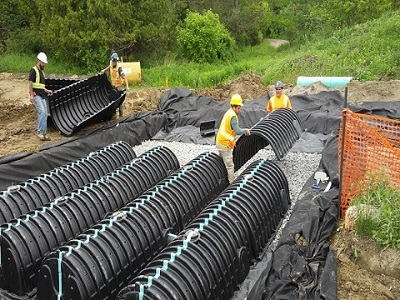How to deal with urban precipitation:Water recycling with rainwater filtration systems
Published on: 2024-09-23 Views: 433
 In order to strengthen the urban drainage system, rainwater can be collected by laying a rainwater harvesting system on the ground, and by filtering the rainwater it can be used to obtain water for plant irrigation, or the treated rainwater can be used for washing cars, cleaning toilets, and so on. The use of rainwater harvesting systems also prevents urban flooding, as our infiltration drains divert rainwater and relieve pressure on the city's main drainage pipes.
In order to strengthen the urban drainage system, rainwater can be collected by laying a rainwater harvesting system on the ground, and by filtering the rainwater it can be used to obtain water for plant irrigation, or the treated rainwater can be used for washing cars, cleaning toilets, and so on. The use of rainwater harvesting systems also prevents urban flooding, as our infiltration drains divert rainwater and relieve pressure on the city's main drainage pipes.Rainwater harvesting systems offer several advantages, including reducing reliance on municipal water supplies, lowering water bills, and decreasing stormwater runoff. They promote sustainable water use, improve groundwater recharge, and can provide a backup water source during shortages. Delving into these systems can ultimately enhance water conservation efforts and support eco-friendly practices.
Rainwater harvesting systems typically include the following features:
Collection Surface: Roofs or other surfaces to collect rainwater.
Gutters and Downspouts: Channels to direct rainwater from the collection surface to storage.
Storage Tanks: Cisterns or barrels to store collected rainwater for later use.
Filtration Systems: Filters to remove debris and contaminants from the rainwater.
Distribution System: Pumps and pipes to deliver harvested rainwater to where it’s needed.
Overflow System: Mechanisms to manage excess water when storage is full, directing it to drainage systems or gardens.
First Flush Diverter: A device to prevent the initial dirty runoff from entering the storage system.
Monitoring Systems: Sensors and gauges to track water levels and usage.
If you need rainwater treatment equipment please contact us and we will organise the right solution for you.
